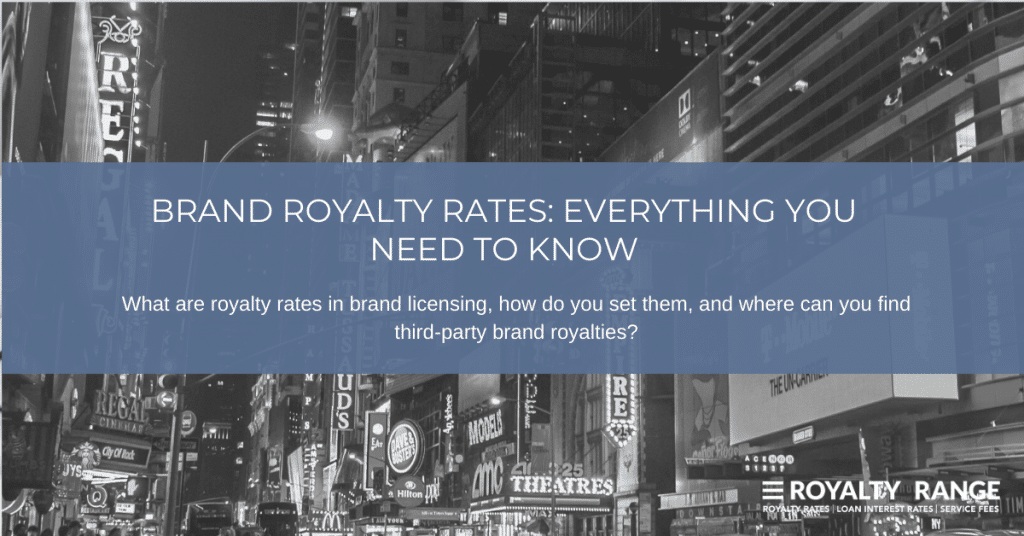Brand royalty rates: everything you need to know

Kris (Kestutis) Rudzika |
January 14, 2020

Brand royalty rates are payments made from a licensee to a licensor in exchange for the use of their brand assets. They are usually a percentage of the revenue generated by the licensee’s use of the brand. Royalty rates make sure that both parties benefit fairly from the license agreement.
In this article, we’ll outline what brand licensing is, why brand owners license their brands, how to set brand royalty rates and where you can find market royalty rates to help with your calculation.
What is brand licensing?
Brand licensing is when a brand owner licenses the right to their brand assets to a licensee, letting the licensee use their brand for a set period of time, in a set way, within an agreed market.
These brand assets can include trademarks, trade names, logos, taglines and anything else that distinguishes the brand’s image – for example, recognizable designs (e.g. the shape of a Coca-Cola bottle), characters (e.g. Ronald McDonald) or slogans (e.g. ‘Maybe she’s born with it’).
In order to go ahead with brand licensing, the brand owner and licensee must agree on the terms and scope of the licensing agreement, which is a legal written contract between the two parties. This will outline exactly what brand assets are being licensed, how they can be used, for how long they can be used, in what market they can be used, and what remuneration is required in return.
Why do brand owners license their brand?
Brand owners choose to license their intellectual property for a number of reasons, such as:
- To meet customer demand: Licensing brand assets to a manufacturer means that brand owners can provide customers with new branded products without having to make them. Apple did this when it launched the iPod – rather than creating headphones and docking stations itself, it licensed its brand so that third parties could manufacture and sell them. It enables the brand owner to meet consumer demand, while providing third-party manufacturers with significant opportunities to grow their business.
- To enter into new markets: By licensing their brand assets, brand owners can put their name to new types of products in new markets, and potentially reach a whole new base of customers. For example, a fashion designer may grant a sunglasses manufacturer the right to use its trademark and logo on a new range of sunglasses. This lets the brand owner build their brand awareness within the accessories market and, at the same time, potentially boosts the manufacturer’s sales through the brand’s established reputation.
- To franchise their business: Another common type of license agreement is a franchise. This is when the brand owner licenses the rights to their business model and the full suite of brand assets. For example, a coffee chain might license its brand and business model to a franchisee, who will essentially replicate the franchise owner’s business and pay brand royalty rates in line with its growth. This lets the licensor extend the reach of its brand, while giving the franchisee a ready-made, tried-and-tested business to start running.
Royalty rates in brand licensing
In license agreements and franchise agreements, the two parties must agree on what remuneration the licensor will receive in exchange for the use of their brand. In most cases, the licensee will have to pay the licensor brand royalty rates. These are usually agreed as a percentage of sales revenue generated through the use of the brand, paid on a regular basis.
Brand royalty rates can be fixed or tiered. In some brand licensing agreements, the royalty rate will go down if a certain sales threshold is met. This incentivizes the licensee to drive sales, and means that any money the licensor loses in lowering the rate is made up for by increased sales.
Setting brand royalty rates
One of the most common ways of establishing fair brand royalty rates is to look at what rates other organizations charged in comparable agreements. This is known as the market approach. To use this method, you need to identify suitably comparable license agreements in which the royalty rate accurately reflects what you could reasonably charge for the use of your brand. If the agreements are not suitably comparable to your situation, your brand royalty rates calculation won’t be reliable.
Here are some factors you need to consider when setting brand royalty rates:
- The size of the market: Brand owners may charge higher brand royalty rates for bigger markets to justify the support they give the licensee with growing within the market.
- The strength of the brand: If a brand is well-established and already has a loyal following and good reputation, the licensor can feasibly charge a premium rate because the value of the brand is higher. Parties should take into account things like the brand’s commercial past, existing customer base and market potential when negotiating brand royalty rates.
- Exclusivity: When a brand owner grants a licensee the exclusive rights to its brand, this may push up the royalty rate as it boosts the brand’s value to the licensee.
Find brand royalty rates today
The quickest and easiest way to find comparable brand royalty rates is to use a royalty rates database like RoyaltyRange. Our database gives you access to the latest brand royalty rates and license agreements, filtered in line with your search criteria. The RoyaltyRange team conducts the search for you and sends you an easy-to-read report of any potentially comparable agreements.
To get started, send us a search request by using the One Search box on the right.
Request One Search
We will perform the search and deliver the initial results within hours, at no cost.




